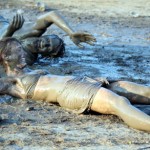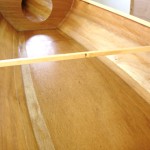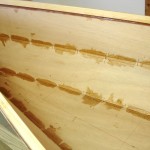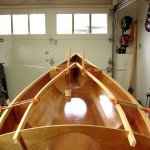 The MAS epoxy I am using is a bit thinner than the West System epoxy I used on the previous boat. It’s low viscosity and absence of amine blush (have to dig deep into epoxy chemistry for that one) make it the preferred choice for sealing and coating, and there’s a lot of that with this type of boat construction.
The MAS epoxy I am using is a bit thinner than the West System epoxy I used on the previous boat. It’s low viscosity and absence of amine blush (have to dig deep into epoxy chemistry for that one) make it the preferred choice for sealing and coating, and there’s a lot of that with this type of boat construction.
Progress on the hull interior is moving along nicely. The bulkheads are now completely fitted, and glued with fillets that make them watertight. The carlin knees are installed. All of the interior surfaces have received two rolled on coats of epoxy as a surface sealant. Short, 4 inch, foam rollers make this coating activity almost enjoyable, and rolling lets me make the coating really thin. Many areas will get two more coats of clear or paint finish and it all adds up to weight that must be carried. The photo shows the carlins being fitted. These are the structural members which support the inner edges of the deck. The “interesting” pair of clamps, sticks, and strings near the far end were used to twist the carlins into “verticality” at that point, a temporary measure while fitting them.
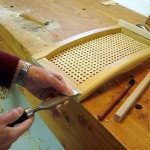 While epoxy cures, there are plenty of small things needing attention. The drawings for this boat include plans for a slatted seat which is made largely from plywood. There are enough plywood cutoffs for this, so it makes good sense. Yet, the design is not one I find appealing. I like traditional cane seats and have purchased yet another from Ed’s Canoe. It’s both a comfortable and beautiful seat. Fitting it is a matter of cutting off the arms which might normally be used for a hanging type mount, and fitting rails to the bottom. The rails get glued to the boat’s bottom and the seat screwed to the rails.
While epoxy cures, there are plenty of small things needing attention. The drawings for this boat include plans for a slatted seat which is made largely from plywood. There are enough plywood cutoffs for this, so it makes good sense. Yet, the design is not one I find appealing. I like traditional cane seats and have purchased yet another from Ed’s Canoe. It’s both a comfortable and beautiful seat. Fitting it is a matter of cutting off the arms which might normally be used for a hanging type mount, and fitting rails to the bottom. The rails get glued to the boat’s bottom and the seat screwed to the rails.
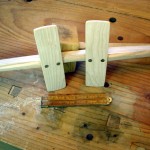 A lightweight traditional style of seat back consists of two curved slats fixed to a yoke shaped cross piece. Again, this is similar to the previous boat. The thin pieces are 1/4 inch thick, resawed left overs. They are shaped by boiling and then clamping to the curved back of some chairs. The yoke is made eight sided and will be cut to the correct length after the deck and coaming parts are done. We’ll see more of it later.
A lightweight traditional style of seat back consists of two curved slats fixed to a yoke shaped cross piece. Again, this is similar to the previous boat. The thin pieces are 1/4 inch thick, resawed left overs. They are shaped by boiling and then clamping to the curved back of some chairs. The yoke is made eight sided and will be cut to the correct length after the deck and coaming parts are done. We’ll see more of it later.
Did you know that epoxy has nearly infinite open time at 40 degrees? Spring squeaked open for a few days and is now squeaking closed again. The forecast for the next few days predicts very slow epoxy curing.
